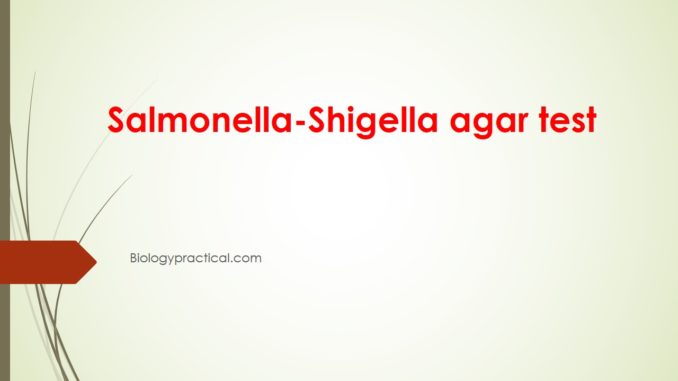
Principle:
Salmonella-shigella (SS) agar is generally employed for the selective isolation and differentiation of Salmonella and Shigella in both clinical and nonclinical samples. However, SS agar is also useful as part of an overall identification plan for other, more unusual gram-negative organisms based on their ability to grow on the medium. SS agar includes bile salts, sodium citrate, brilliant green and neutral red dyes that inhibits growth of most gram-positive and many gram-negative organisms. SS agar is similar to MAC and can differentiate among the lactose fermenting and non-lactose-fermenting organisms, but it is more inhibitory in nature. Sodium thiosulfate and ferric citrate allows the detection of hydrogen sulphide production as indicated by colonies with black centres. Differentiation of organisms is facilitated by lactose i.e. the lactose fermenters will produce acid and turn the neutral red indicator to red/pink whereas those who are not capable to ferment lactose will form colourless colonies. Other ingredients in the medium such as enzymatic digest of casein, beef extract etc provides essential nutrients (carbon, nitrogen, and vitamins) essential for growth of organism.
Composition of salmonella- Shigella agar:
Ingredients gm/litre
- Beef extract 5.00
- Lactose 10.00
- Bile salts 8.50
- Sodium citrate 8.50
- Sodium thiosulfate 8.50
- Enzymatic digest of casein 2.50
- Enzymatic digest of animal tissue 2.50
- Ferric citrate 1.00
- Neutral Red 0.025
- Brilliant Green 0.00033
- Agar 13.50
Distilled water = 1000ml, pH(at 25°C)= 7.0 ±0.2
Requirements:
- SS agar
- Sterile Inoculating loops
- Incubator at 35°C
Procedure:
For the preparation of media:
- Weigh 60gm of medium and suspend it in 1 litre distilled water.
- Stir it well, while heating and boil for a minute.
- No need to autoclave.
- Dispense it in slants, test tubes and tighten the caps.
For the culturing of sample:
- Inoculate 1 or 2 drops from an overnight broth culture or one or two colonies from a fresh plate to the agar slant or plate.
- Streak slant in a zigzag direction across the slant and streak plate in quadrants for isolation of colonies.
- Incubate aerobically for up to 7 days at 35°C, and observe for visible growth.
Results interpretation:
- Positive result:
- If the medium turns red, that indicates the lactose fermentation and the red colour is due to acidic pH . Klebsiella pneumoniae shows red colour to SS agar.
- Salmonella and Shigella along with other microorganisms that are not capable of fermenting lactose are visible as transparent or translucent colonies.
- E. coli gives pink or red coloured colonies
- Negative result:
- No growth in agar medium is suggestive of negative test.

